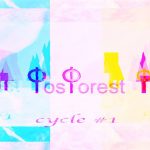
Cycle #1 is the debut release from ambient soundscape creator Phosforest. Side 1 was made as a self-led challenge to put an album together in 3 hours, using a combination of pre-recorded and improvised material. Inspired by the wilderness of Arctic Norway where the album was made, and incorporating field recordings and improvisations from a trip to Iceland back in 2018, it represents an idea of peace that allows for the mundanity and cacophony of everyday life.
Side 2 was an idea harking back to the days of tape, which takes an ‘I wonder what would happen if…’ approach, in which the tracks of Side 1 are reversed and slightly altered.
Here, the artist tells us more about the inspirations behind it…
Phosforest is inspired by ambient music and experimental improvisation, coupled with the isolation and expanse of living on an island in Arctic Norway.
After the first Covid-lockdown in the UK, I decided to move to Arctic Norway with my then partner to see if we could set up various online remote projects. She knew people up there who were setting up an Arts and Cultures hub and it seemed like the perfect place to get away from Covid and focus on arts and creative makings. It ended up being a huge mix of adventure, disaster, beauty and difficulty in equal measure.
While I was there I was working on my first Tobias Sarra album (A Beige Kind of Grey, which came out in December ’21). The process for that album was a long one, giving space for development to occur naturally without pushing too much – I had no real deadline other than that I wanted it made. I think I was coming towards the end of production around the Summer months, and I decided I wanted to make something new.
I challenged myself to make an album in roughly 3 hours, start to finish, using a combination of pre-recorded material I already had on my hard drive and new improvisations. The result was Phosforest – Cycle #1.
A lot of the recordings I took from the hard drive came from a trip to Iceland back in 2018, so there’s definitely a shared sense of ‘the far north’ across the record. The underlying nature track was collected there whilst out on a nature walk. I was working on a multi-disciplinary piece, and the guy I was working with had trained as an osteopath – we did an exercise where he’d give me osteopathy (a very peaceful therapy-form), and then I’d play something, trying to maintain the stillness that I’d got to through the osteopathy. We were both really excited by the idea of spaciousness and I was trying to encapsulate that musically. So Peace-in-slithers was recorded straight after a session. The electric organ on Fyre Grumbles was also recorded up there, though distinctly not post-osteo.
I’ve been into ambient music for a long time, probably coming to it through post-rock (can I call it that?), bands like Sigur Rós, Mogwai and The Breathing Effect back in sixth form. These days I’m really influenced by Hiroshi Yoshimura, Éliane Radigue, K. Leimer, Ana Roxanne, Sara Davachi, Claire Rousay and Tarkovsky Quartet, as well as the ideas of John Cage and the Fluxus movement. I’m also madly into Tori Kudo, a Japanese avant-garde artist who’s a big inspiration from the world of naive art/music.
I played for some time with Newcastle-based zen-improv extraordinaires ‘Shunyata Improvisation Group’. The experience of playing in that band also taught me a lot about using and allowing for space, and a lot of it!
These musical experiences, alongside the vast endlessness of the Arctic wildness, were a huge influence on this album. I’ve tried to create a sense of ambience and naivety in equal measure, a loose-fitting, lo-fi sound that doesn’t shy away from mundanity and doesn’t try too hard to correct itself.
With it being Summer in Arctic Norway when I made this, i.e., no sunset, the first thing I did after making the album was upload a rough draft to my phone, and then went for a walk across the island. I met a whole flock of seagulls who were currently in nesting season, and as they were circling overhead it was the most terrified I’d ever been that I might die a ‘death by seagull’. Listening to the album on the way back, it felt really beautiful being out on the land with it, and definitely eased any lingering anxiety I might’ve been feeling. For me it’s a reminder of that time, and hopefully, it can take listeners to a similar place.
On a side note, I was calling the project ‘Blós’ for quite a while, which doesn’t actually mean anything, but I liked the way it sounded and it felt like it connected to the land in the same way the album did. I changed the name when I found out there was a Newcastle-based hardcore/ noisepunk band called ‘Blóm’ (what’re the chances?).